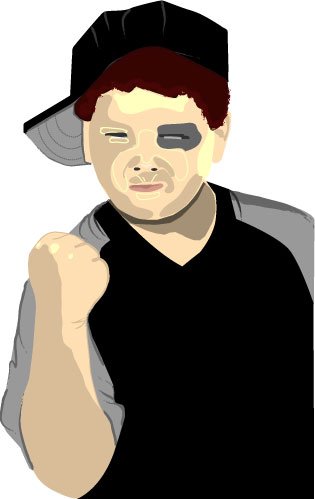Roger Cornia, school safety administrator for the Gilroy Unified
School District, remembers a time someone put his brother in the
hospital. Cornia was 5 years old and playing basketball with his
11-year-old brother at a court outside of school.
Roger Cornia, school safety administrator for the Gilroy Unified School District, remembers a time someone put his brother in the hospital. Cornia was 5 years old and playing basketball with his 11-year-old brother at a court outside of school.
“This guy didn’t like my brother and just wanted to beat him up,” Cornia recalled. “I went to my brother to help him, and (the guy) kicked me in my side.”
As a result, Cornia broke a rib while his brother, who was hit on the head with a rock, had to be hospitalized. Physical wounds may have gotten better over time, but the memory of the incident remains.
“It was ugly, it scared me,” Cornia said. “I can really relate to kids who are suffering in silence. As an adult, I think, ‘I don’t want a kid to go through that.’ ”
Irene van der Zande, executive director and co-founder of Kidpower International, shares a similar experience.
“I was a kid that was shunned by a group of girls,” she said. “I didn’t think it affected me that much until my own daughter started school and the huge anxiety I had for her. It was directly related to the hard time I had had.”
Cornia and van der Zande’s experiences illustrate how bullying can leave long-lasting impressions. Ask any adult, van der Zande suggests, and you will find that many of them speak with a lot of energy about something that happened decades ago.
As 7-year-old Darrien Glover puts it, “It hurts my heart.”
The Luigi Aprea second-grader has had his Gameboy advance cartridges stolen and broken. In one instance, his Pokemon Ruby Version – a gift from the Easter Bunny – was taken.
“It makes me sad, but I also feel bad for (the bullies),” he said.
Glover’s sympathy for bullies indicates his understanding of a simple, sometimes overlooked truth: the fact that bullies are human too.
Epic tales like the popular “Harry Potter” series, tend to cast characters in good-versus-evil roles. Innocent and courageous kids battle Lord Voldemort, the through-and-through evil villain. While black-and-white, good-versus-evil typecasting may make for thrilling drama in fiction, in real life, in school playgrounds, things are much more complex.
“Very rarely are any of us angels or devils,” van der Zande said. “If people think about it honestly, most of us can think of at least one time in our life when we bullied someone else. Maybe it was a younger sibling, or maybe it was a friend, or maybe it was a new kid at school.”
Identifying causes for bullying is not clear-cut either. Some may bully others out of fear, while others may be copying something that happens at home. Kids may also be pushing boundaries, experimenting with power and may find that bullying makes them feel important. There are however, things that parents and administrators can do to prevent such behavior.
Van der Zande suggests a two-pronged approach.
“There’s the end of making it against the rules, there’s the end of giving people better tools for handling something that’s going to come up. …Trying to ignore it or pretend it didn’t happen will make the problem bigger.”
At the Gilroy Unified School District, bullying is a topic Cornia is concerned with and often discusses with school principals.
“I think bullying is definitely on the increase,” he said. “It’s not nearly as bad as it was one time years and years ago, but it is on the increase and we have to stop it.”
At the beginning of each school year, students are issued handbooks detailing the behavior expected of them, explains Cornia. These guidelines are tailored to each school, but all follow the state Education Code. As part of California laws relating to minors, the Education Code addresses student discipline and issues like grounds for suspension. The Code explicitly mentions things like robbery, drugs, firearms and obscene acts.
Forms of bullying such as name-calling and ostracizing are up to the school administration and involved parents to handle.
One way schools handle bullying on the playground is to have supervisors on site. Seven-year-old Victor Ortiz Gomez knows that he can turn to an authority figure when older kids push him.
“I tell the yard duty,” the first-grader at Eliot Elementary said. “They make them sit on a bench.”
Although Victor is comfortable getting help, others are not.
“We’re asking students to tell us, but often they won’t tell us because they’re being bullied,” Cornia said. “If we don’t know about it, there’s little we can do. We’re trying to identify a way that students can report it so that those students (who bully) don’t do it anymore.”
While concern about bullying incidences usually goes out to the victim and the bully, van der Zande points out that bystanders too are negatively affected. Witnessing someone else getting bullied often provokes feelings of fear– that it might happen to them–and guilt– that they didn’t do anything to stop it.
“Some people can put things like that in a box and forget about it,” she said, “But for other people, it can create a world view that’s not a very happy one. Kids deserve to have a positive and safe environment in which to be in school.”
To find out more, visit the GUSD at www.gusd.k12.ca.us or Kidpower at www.kidpower.org.
WHAT TO DO IF YOUR CHILD IS BULLIED
Although it is natural to feel anger when your children tell you they are being bullied, it is important for you to calm down, van der Zande writes in the December issue of Kidpower’s e-newsletter. If they see that you are upset, they too may get upset. This may prompt them to avoid the topic entirely in the future.
Also, acting upset when you approach school administrators may put them on the defense rather than truly addressing the problem. If approached in a respectful manner, administrators are likely to share your concern in getting to the root of the issue.
Rather than trying to “get even” with the bully or assigning blame, van der Zande recommends looking for solutions. Your goal is to understand what happened and figure out how best to address the situation. “Try to assume that children who have hurtful behavior do this because they do not have a better way of meeting their needs or because they have problems in their own lives,” she advises.
Many bullying incidents can take place off school grounds, but carry over onto campus. Cornia asks parents to notify school administrators so that a collective effort can be made.
WHAT TO DO IF YOUR CHILD BULLIES
Boundaries need to be set for children who bully. Rules for behavior and consistent consequences for when those rules are broken need to be clear. Children need to see that the same set of rules are followed by the people around them, especially the adults.
“There should be a conscious, determined and sustained effort made to not have bullying,” van der Zande says. She suggests teaching the child safer, less violent tools for getting what they want and better ways for dealing with disappointment when they don’t.
Parents should keep in mind the complexity of their children. “Treat the situation and the children involved as unique beings who are worthy of respect and who can change, instead of framing something as an irreversible character flaw,” van der Zande said. “That’s why we try to talk about bullying behavior instead of bullies.”














